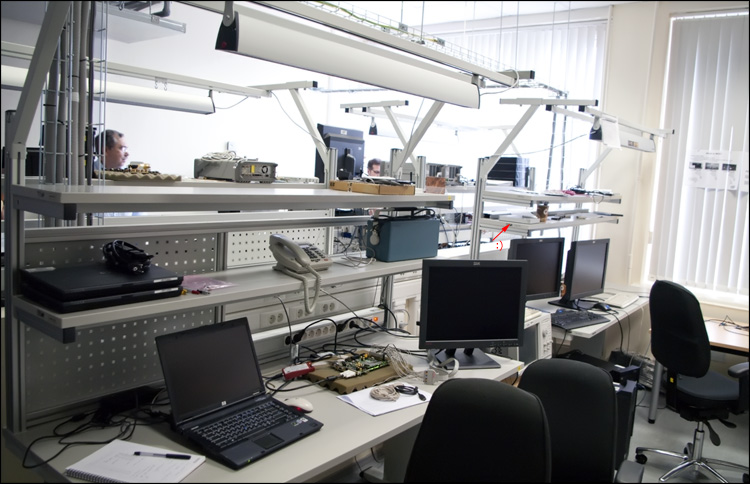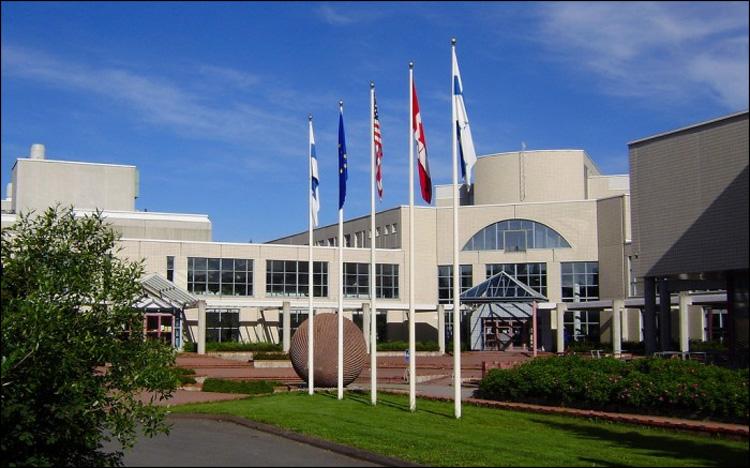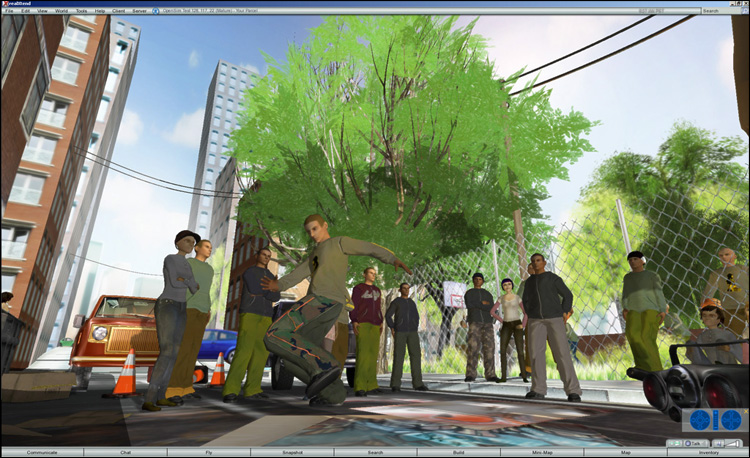Intel and Nokia Collaborative Research Center
Recently, Intel’s office in St. Petersburg was visited by Justin Rattner (Intel’s chief technology officer), who answered numerous questions from media representatives.

“We decided to combine our efforts to jointly develop three-dimensional image technologies, more convenient user interfaces and new applications. Do not forget that we live in three-dimensional space, and computer displays force us to accept their limitations and conventions and force us to live in a two-dimensional world. But 3D games will soon appear with much more exciting features. But the possibilities of three-dimensional interfaces are much broader than just the entertainment sphere - this is a real breakthrough in all spheres of human life. Now it is difficult to say in which year all this will appear in real devices, because for the time being we are just starting joint research in this area. But what’s important is that we are moving from a device development concept based on the capabilities of technology to a different principle based on user needs. .
- I do not think so. Today x86 is in great shape. In 2005, the head of our company Paul Otellini (Paul Otellini) said that in 5 years the performance of processors will increase 10 times and their power consumption will decrease as many times. But these figures were achieved much earlier, by 2008. Intel Atom processors today demonstrate a record low power consumption, and Nehalem - record performance, and all this using x86. For the next 10 years, this trend will continue, and we will make processors 10 times more powerful and 10 times more economical.
To keep this trend, we are allowed by the fact that we make the best transistors on this planet. In addition, we learned how to save electricity at the processor level, but also other hardware components, as well as using programs.
That is why, together with Nokia, we are now actively developing a new open source operating system for MeeGo mobile devices in order to be sure that all the capabilities of the equipment are used as efficiently as possible. I am absolutely sure that in the coming years, x86 architecture will remain the most common. We have proved its flexibility and power so many times that, in my opinion, it feels most comfortable today.
I talked about performance and power consumption, but there is also a third axis for the development of architecture - security. I must tell you that in the next five years, completely revolutionary changes await us in this area. The possibility of working with malware on our chips will be completely eliminated. And the attacks of intruders who today literally terrorize Internet users will be blocked at the hardware level. This is important because you can hack the operating system and any application, but you can only hack the device with a mechanical tool :)
')
- Of course. We want to embed the security function in the architecture of our processors in the next 5 years and to solve this problem we involve the best experts in this field. And McAfee is just a storehouse of specialists. With their help, we will be able to make a revolutionary breakthrough in protecting information from unauthorized access and secure tens of millions of our users and billions of devices.

- I said that the capabilities of artificial intelligence will be equal to the capabilities of the human brain, and this is not the same thing. This does not mean that we can build the brain of transistors. I never thought that artificial intelligence would be in its structure similar to human. Birds do not fly like man-made airplanes and fish swim differently than our ships. Artificial intelligence will be built on other principles than ours, but according to their capabilities they will be equal, and this will happen, perhaps, sooner than we expect today.
The fact is that 2 years ago we celebrated the 40th anniversary of Intel, which is why I tried to look exactly 40 years ahead. But electronic devices will become smarter and smarter literally in the coming years. Your email assistant will determine where you are and relate the location to your work schedule, calendar of events and meetings. He will be able to issue such advice: “You need to fly out of Sheremetyevo in 4 hours, there are serious traffic jams on the route, so it makes sense for you to leave now.” And such artificial intelligence functions in electronic devices will become more and more, and you will increasingly rely on their help.
- A very good question, I would say, provocative. Yes, of course, now social networks are very popular, and in these networks, sometimes a computer can already perform certain functions on behalf of the owner. Computers increasingly communicate with each other. In fact, this is already a realization of oneself to some extent as individuals, even at a primitive level. This is a precursor to the emergence of a computer community. But a more serious level of awareness of themselves as individuals is in science fiction, I do not consider myself to be a fantasy.
- In different countries, this happens differently, but always to mutual pleasure and benefit. The specific model depends on differences in the principles of university funding. In Europe, for example, adopted its own principle, very different from the American. And what about China and India! We try to “fit” our research into the research and development system adopted in a particular university in a particular country. But always ready to offer universities the development of the most interesting and advanced topics. Earlier we tried to give grants for the solution of the nearest research tasks, but then we came to the conclusion that it is better to cooperate for a 10-year and even more distant perspective. However, we still have individual grants programs in areas such as visual computer environments, parallel computing — universities in Germany and the USA receive them.
- Here, just during my current visit, we actively discussed it. It is very important that the Russian government is now actively involved in the development of high technologies. An analogue of Silicon Valley is being created - the Skolkovo project. Our former leader, Craig Barrett, is on his supervisory board. I am sure that this project has a great future.
 Article partially taken from Intel Galaxy
Article partially taken from Intel Galaxy
Let's see what will happen next. In September, Nokia is holding a major event, Nokia World - perhaps something interesting will show there.
Successes!

| Justin Rattner - CEO of Intel Corporation for Technology (Chief Technology Officer), Vice President, Head of the Network of Research Centers at Intel Labs and Senior Honorary Research Engineer (Senior Intel Fellow) - has worked at Intel since 1973. In 1979 He became a leading engineer, and in 1988 - the fourth in a row in the history of the corporation Honorary Research Engineer (Intel Fellow). |
- On August 24, 2010, Intel and Nokia announced the creation of a joint development center in Finland. What will it give to both industry leaders?
“We decided to combine our efforts to jointly develop three-dimensional image technologies, more convenient user interfaces and new applications. Do not forget that we live in three-dimensional space, and computer displays force us to accept their limitations and conventions and force us to live in a two-dimensional world. But 3D games will soon appear with much more exciting features. But the possibilities of three-dimensional interfaces are much broader than just the entertainment sphere - this is a real breakthrough in all spheres of human life. Now it is difficult to say in which year all this will appear in real devices, because for the time being we are just starting joint research in this area. But what’s important is that we are moving from a device development concept based on the capabilities of technology to a different principle based on user needs. .
- Do you think that x86 architecture has already exhausted itself logically and something new should come to replace it?
- I do not think so. Today x86 is in great shape. In 2005, the head of our company Paul Otellini (Paul Otellini) said that in 5 years the performance of processors will increase 10 times and their power consumption will decrease as many times. But these figures were achieved much earlier, by 2008. Intel Atom processors today demonstrate a record low power consumption, and Nehalem - record performance, and all this using x86. For the next 10 years, this trend will continue, and we will make processors 10 times more powerful and 10 times more economical.
To keep this trend, we are allowed by the fact that we make the best transistors on this planet. In addition, we learned how to save electricity at the processor level, but also other hardware components, as well as using programs.
That is why, together with Nokia, we are now actively developing a new open source operating system for MeeGo mobile devices in order to be sure that all the capabilities of the equipment are used as efficiently as possible. I am absolutely sure that in the coming years, x86 architecture will remain the most common. We have proved its flexibility and power so many times that, in my opinion, it feels most comfortable today.
I talked about performance and power consumption, but there is also a third axis for the development of architecture - security. I must tell you that in the next five years, completely revolutionary changes await us in this area. The possibility of working with malware on our chips will be completely eliminated. And the attacks of intruders who today literally terrorize Internet users will be blocked at the hardware level. This is important because you can hack the operating system and any application, but you can only hack the device with a mechanical tool :)
')
- Obviously, this motive became the main one when deciding on the acquisition of McAfee?
- Of course. We want to embed the security function in the architecture of our processors in the next 5 years and to solve this problem we involve the best experts in this field. And McAfee is just a storehouse of specialists. With their help, we will be able to make a revolutionary breakthrough in protecting information from unauthorized access and secure tens of millions of our users and billions of devices.

- Two years ago at the Developer Developer Forum (Intel Developer Forum) you said that by 2050 the capabilities of computers would be equal to those of the human brain. Has your forecast changed?
- I said that the capabilities of artificial intelligence will be equal to the capabilities of the human brain, and this is not the same thing. This does not mean that we can build the brain of transistors. I never thought that artificial intelligence would be in its structure similar to human. Birds do not fly like man-made airplanes and fish swim differently than our ships. Artificial intelligence will be built on other principles than ours, but according to their capabilities they will be equal, and this will happen, perhaps, sooner than we expect today.
The fact is that 2 years ago we celebrated the 40th anniversary of Intel, which is why I tried to look exactly 40 years ahead. But electronic devices will become smarter and smarter literally in the coming years. Your email assistant will determine where you are and relate the location to your work schedule, calendar of events and meetings. He will be able to issue such advice: “You need to fly out of Sheremetyevo in 4 hours, there are serious traffic jams on the route, so it makes sense for you to leave now.” And such artificial intelligence functions in electronic devices will become more and more, and you will increasingly rely on their help.
- Does this mean that computers will become aware of themselves as personalities?
- A very good question, I would say, provocative. Yes, of course, now social networks are very popular, and in these networks, sometimes a computer can already perform certain functions on behalf of the owner. Computers increasingly communicate with each other. In fact, this is already a realization of oneself to some extent as individuals, even at a primitive level. This is a precursor to the emergence of a computer community. But a more serious level of awareness of themselves as individuals is in science fiction, I do not consider myself to be a fantasy.
- Tell us how Intel labs work with universities.
- In different countries, this happens differently, but always to mutual pleasure and benefit. The specific model depends on differences in the principles of university funding. In Europe, for example, adopted its own principle, very different from the American. And what about China and India! We try to “fit” our research into the research and development system adopted in a particular university in a particular country. But always ready to offer universities the development of the most interesting and advanced topics. Earlier we tried to give grants for the solution of the nearest research tasks, but then we came to the conclusion that it is better to cooperate for a 10-year and even more distant perspective. However, we still have individual grants programs in areas such as visual computer environments, parallel computing — universities in Germany and the USA receive them.
- How is Intel cooperating with Russian universities now?
- Here, just during my current visit, we actively discussed it. It is very important that the Russian government is now actively involved in the development of high technologies. An analogue of Silicon Valley is being created - the Skolkovo project. Our former leader, Craig Barrett, is on his supervisory board. I am sure that this project has a great future.
Some details about the joint research center of Intel and NokiaIn one of the largest universities in Finland (namely, Oulu, located in the same town), Intel and Nokia open the first joint research center.  The center is being created on the basis of the Center for Internet Excellence organization, and already this month two dozen scientists will be working there to create new user interfaces for mobile devices. Justin at a press conference on the opening of the center: “ In the past few years, we have seen the ubiquitous spread of mobile Internet devices: smartphones, tablets, netbooks, and so on. Every day it becomes more and more obvious that all these devices are distinguished from others by what we call user experience, user experience. Now it is not enough to pack hardware stuffing into the device: a processor, a screen, communications, and so on, and stop there. Now you need to be well aware of who will use such a device, and for what. According to Ratner, in modern mobile devices, the user interface is the basis of the entire design of the device, so the opening of a joint research center in Oulu is an excellent opportunity to do research in this area. The center in Oulu will become the 22nd Intel research center in Europe - and the most northern of them. The main work will focus on 3D technologies in new generations of mobile devices, for example, on realXtend , an open source platform for creating interconnected virtual 3D worlds similar to the popular three-dimensional social network Second Life. Rich Green , technical director of Nokia: “The capabilities of modern devices should be limited to the user interface, the problem of implementation of which is becoming more and more pressing. The user interface is a bridge between the human mind and the technological capabilities of computing devices, so we open a research center in Oulu just to connect these two worlds with Intel . ”  One of the highlights of the new center is the possibility of publishing research results in the form of open source projects. For both Intel and Nokia, this is not the first experience with open source projects - Nokia began work on the Maemo platform several years ago, and now has teamed up with Intel on MeeGo, an open platform for a variety of mobile devices: smartphones , netbooks, tablets, car electronics and so on. Of course, it’s too early to talk about the specific results of the work of the new laboratory, but representatives of both companies do not exclude that they can be integrated into the developing MeeGo platform. Now the laboratory is almost entirely focused on creating three-dimensional user interfaces for mobile devices. “ In the past two or three years, there has been a shift in our activities from the pursuit of pure performance to how we can use the capabilities of the devices we are developing to create much simpler and more accessible user interfaces, ” Justin says. |
Let's see what will happen next. In September, Nokia is holding a major event, Nokia World - perhaps something interesting will show there.
Successes!
Source: https://habr.com/ru/post/102862/
All Articles